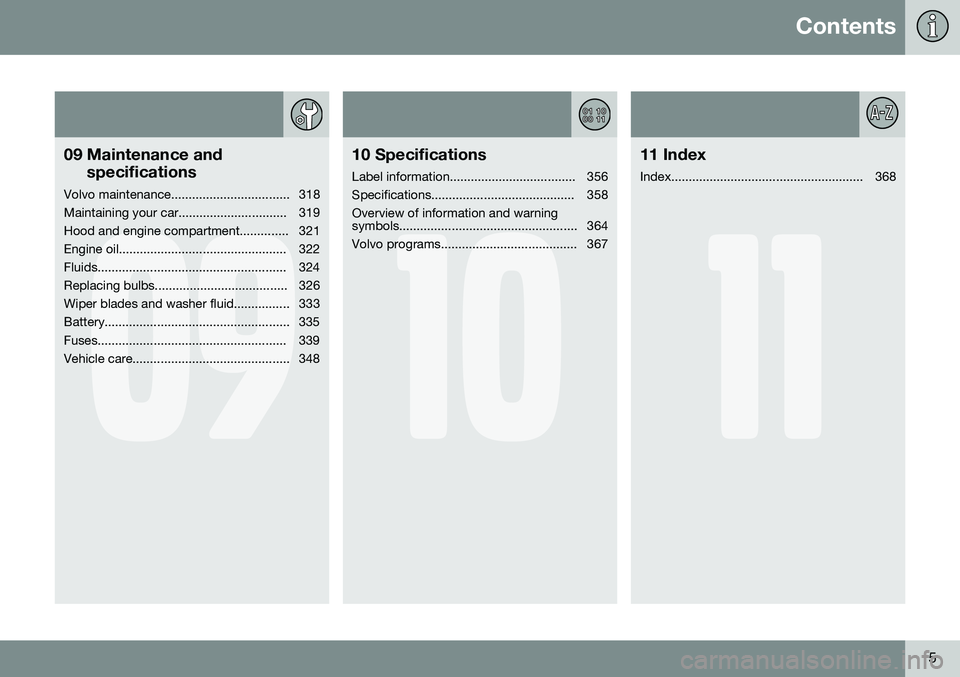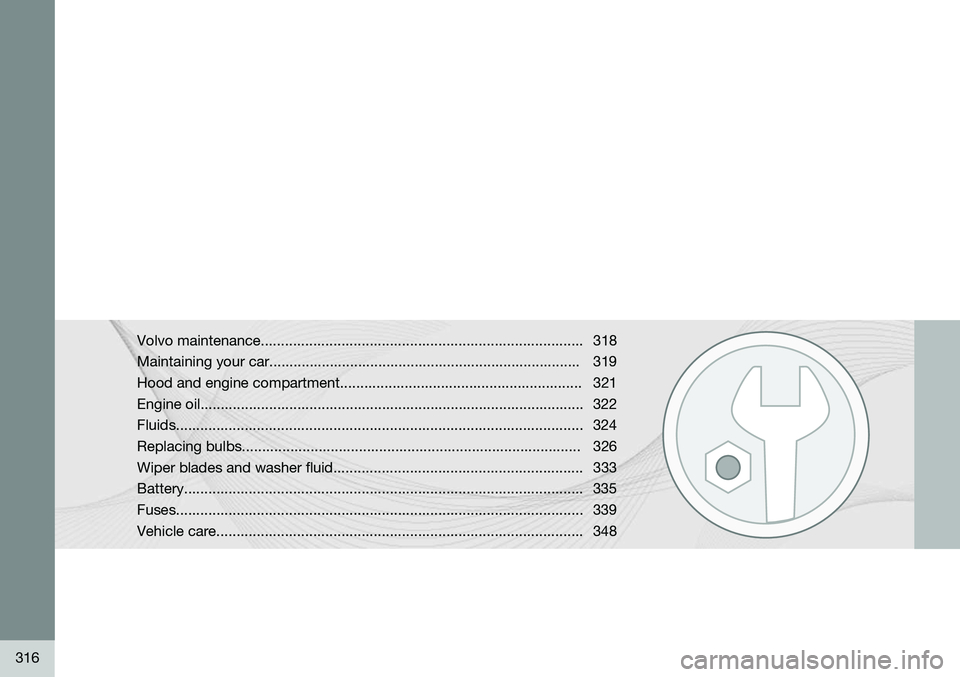Page 7 of 380

Contents
5
09
09 Maintenance andspecifications
Volvo maintenance.................................. 318
Maintaining your car............................... 319
Hood and engine compartment.............. 321
Engine oil................................................ 322
Fluids...................................................... 324
Replacing bulbs...................................... 326
Wiper blades and washer fluid................ 333
Battery..................................................... 335
Fuses...................................................... 339
Vehicle care............................................. 348
10
10 Specifications
Label information.................................... 356
Specifications......................................... 358Overview of information and warning
symbols................................................... 364
Volvo programs....................................... 367
11
11 Index
Index....................................................... 368
Page 272 of 380

07 During your trip
Driving recommendations
07
270
Before a long distance tripIt is always worthwhile to have your vehicle checked by a trained and qualified Volvoservice technician before driving long dis-tances. Your retailer will also be able to sup-ply you with bulbs, fuses, spark plugs andwiper blades for your use in the event thatproblems occur. As a minimum, the following items should be checked before any long trip:• Check that engine runs smoothly and that fuel consumption is normal.
• Check for fuel, oil, and fluid leakage
• Have the transmission oil level checked.
• Check condition of drive belts.
• Check state of the battery's charge.
• Examine tires carefully (the spare tire aswell), and replace those that are worn.Check tire pressures.
• The brakes, front wheel alignment, andsteering gear should be checked by atrained and qualified Volvo service techni-cian only.
• Check all lights, including high beams.
• Reflective warning triangles are legallyrequired in some states/provinces.
• Have a word with a trained and qualifiedVolvo service technician if you intend to drive in countries where it may be difficultto obtain the correct fuel.
• Consider your destination. If you will bedriving through an area where snow or iceare likely to occur, consider snow tires.
Cold weather precautionsIf you wish to check your vehicle before the approach of cold weather, the followingadvice is worth noting:
• Make sure that the engine coolant con- tains 50 percent antifreeze. Any othermixture will reduce freeze protection. Thisgives protection against freezing down to–31 °F (–35 °C). The use of "recycled"antifreeze is not approved by Volvo. Dif-ferent types of antifreeze must not bemixed.
• Volvo recommends using only genuineVolvo antifreeze in your vehicle's radiator.
• Try to keep the fuel tank well filled – thishelps prevent the formation of condensa-tion in the tank. In addition, in extremelycold weather conditions it is worthwhileto add fuel line de-icer before refueling.
• The viscosity of the engine oil is impor-tant. Oil with low viscosity (thinner oil)improves cold-weather starting as well asdecreasing fuel consumption while theengine is warming up. Full synthetic0W-30 oil is recommended for driving inareas with sustained low temperatures. •
The load placed on the battery is greaterduring the winter since the windshieldwipers, lighting, etc., are used moreoften. Moreover, the capacity of the bat-tery decreases as the temperature drops.In very cold weather, a poorly chargedbattery can freeze and be damaged. It istherefore advisable to check the state ofcharge more frequently and spray an anti-rust oil on the battery posts.
• Volvo recommends the use of snow tireson all four wheels for winter driving, seepage 300.
• To prevent the washer fluid reservoir fromfreezing, add washer solvents containingantifreeze. This is important since dirt isoften splashed on the windshield duringwinter driving, requiring the frequent useof the washers and wipers. Volvo WasherSolvent should be diluted as follows:Down to 14 °F (–10 °C): 1 part washersolvent and 4 parts water Down to 5 °F(–15 °C): 1 part washer solvent and3 parts water Down to 0 °F (–18 °C):1 part washer solvent and 2 parts waterDown to –18 °F (–28 °C): 1 part washersolvent and 1 part water.
• Use Volvo Teflon Lock Spray in the locks.
• Avoid using de-icing sprays as they cancause damage to the locks.
Page 318 of 380

316
Volvo maintenance................................................................................ 318
Maintaining your car............................................................................. 319
Hood and engine compartment............................................................ 321Engine oil............................................................................................... 322Fluids..................................................................................................... 324
Replacing bulbs.................................................................................... 326
Wiper blades and washer fluid.............................................................. 333Battery................................................................................................... 335Fuses..................................................................................................... 339Vehicle care........................................................................................... 348
Page 341 of 380

09 Maintenance and specifications
Fuses09
339
Replacing fuses
There are relay/fuse boxes located in the engine compartment, the passenger com-partment, and the trunk. If an electrical component fails to function, this may be due to a blown fuse. The easiestway to see if a fuse is blown is to remove it. To do so:
1. Pull the fuse straight out. If a fuse is diffi-cult to remove, a special fuse removal tool is located on the inside of the enginecompartment fuse box cover.
2. From the side, examine the curved metal wire in the fuse to see if it is intact.
If the wire is broken, insert a new fuse of thesame color and amperage (written on thefuse). If fuses burn out repeatedly, have the electri- cal system inspected by a trained and quali-fied Volvo service technician.
WARNING
Never use metal objects or fuses with higher amperage than those stated on thefollowing pages. Doing so could seriouslydamage or overload the vehicle's electricalsystem.
Location of the fuse boxes
Engine compartment
Under the glove compartment
Under the glove compartment
Trunk
Not in use
Page 342 of 380
09 Maintenance and specifications
Fuses 09
340
Engine compartment
Page 343 of 380

09 Maintenance and specifications
Fuses09
* Option/accessory, for more information, see Introduction.341
Engine compartment, upper
Engine compartment, front
Engine compartment, lower
PositionsThese fuses are all located in the engine com- partment box. Fuses in
are located under
.
A decal on the inside of the cover shows the positions of the fuses.
NOTE
• Fuses 16 – 33 and 35 – 41 may be changed at any time when necessary.
• Fuses 1 – 15, 34 and 42 – 44 arerelays/circuit breakers and should onlybe removed or replaced by a trainedand qualified Volvo service technician.
• There is a special fuse removal tool onthe underside of the cover.
PosFunctionA
Circuit breaker50
Circuit breaker50
Circuit breaker60
PosFunctionA
Circuit breaker60
Circuit breaker60
–
–
Headed windshield*, driver's side40
Windshield wipers30
–
Climate system blower40
Headed windshield*, passenger's side40
ABS pump40
ABS valves20
Headlight washers20
Active Bending Lights- headlight leveling*10
Central electrical mod- ule20
PosFunctionA
ABS5
Speed-dependent steering force*5
Engine Control Module (ECM), transmission,SRS10
Heated washer noz- zles*10
-
Lighting panel5
-
-
-
Relay - engine com- partment box5
Auxiliary lights*20
Horn15
Engine Control Module (ECM)10
Page 344 of 380
09 Maintenance and specifications
Fuses 09
342
PosFunctionA
Control module - auto- matic transmission15
A/C compressor15
Relay-coils5
Starter motor relay30
Ignition coils20
Engine Control Module10
Injection system, mass air meter, engine con-trol module15
A/C compressor, engine valves, enginecontrol module (6-cyl.),solenoids (6-cyl. non-turbo only), mass airmeter (5-cyl. only)10
EVAP valve, heated oxygen sensor15
-
Fuel leakage detection5
PosFunctionA
–
Cooling fan80 (6-cyl. engine)
Electro-hydraulic power steering100
Page 345 of 380
09 Maintenance and specifications
Fuses09
}}
* Option/accessory, for more information, see Introduction.343
Under the glove compartment
Fold aside the upholstery covering the fuse boxes.
1. Press the cover's lock and fold it up.
2. The fuses are accessible.A decal on the inside of the cover shows the positions of the fuses.Positions: fuse box A
PosFunctionA
Circuit breaker for the info- tainment system and for fuses16-20,40
-
-
Electrically heated steering wheel*10
-
PosFunctionA
-
12-volt socket (trunk)15
Controls in driver's door20
Controls in front passenger's door20
Controls in right rear pas- senger's door20
Controls in left rear passeng- er's door20